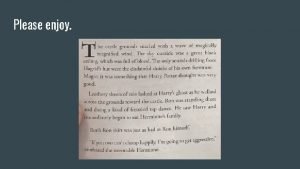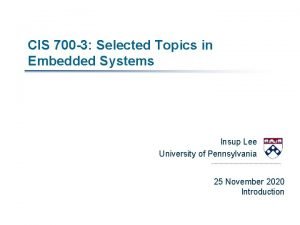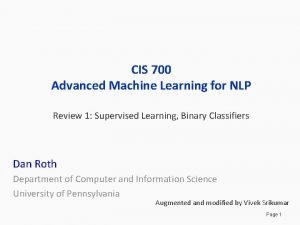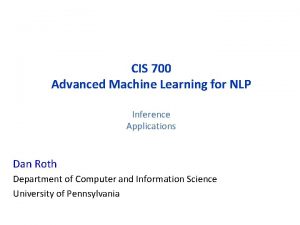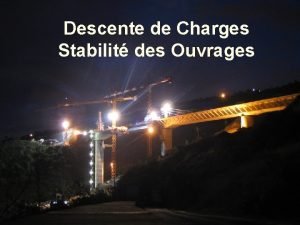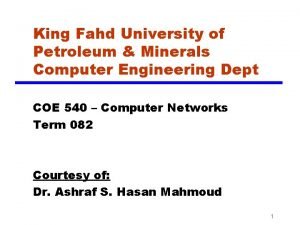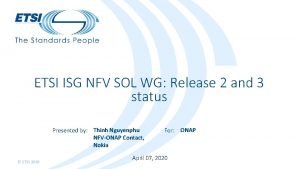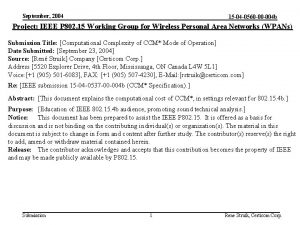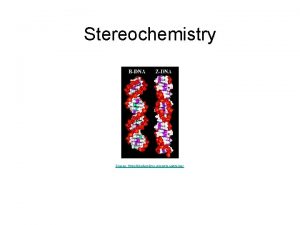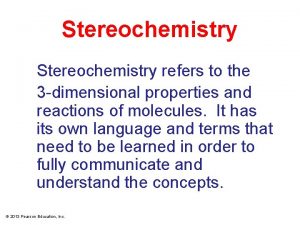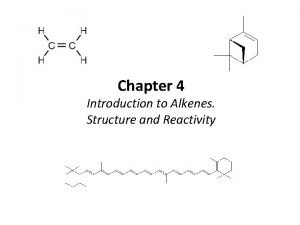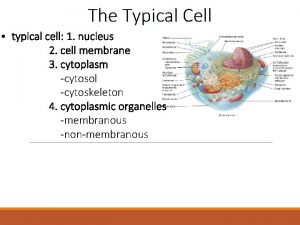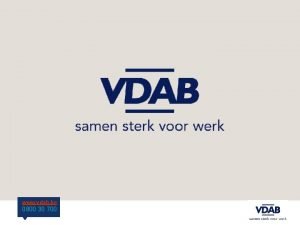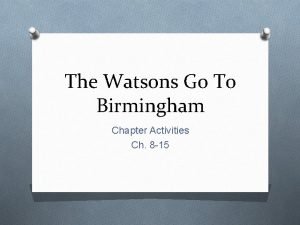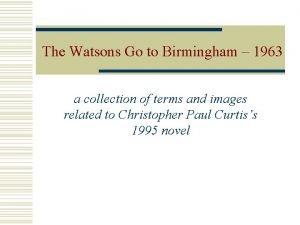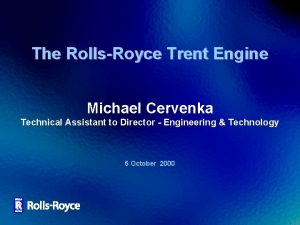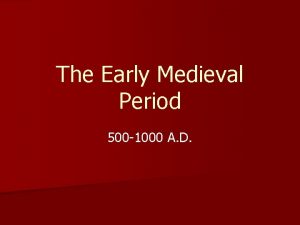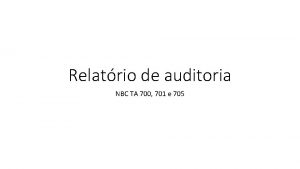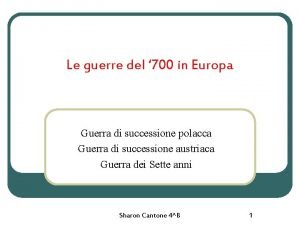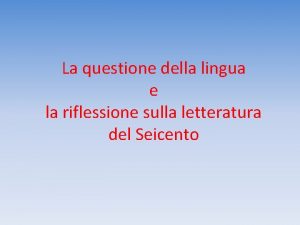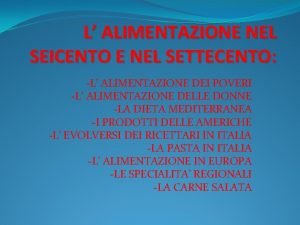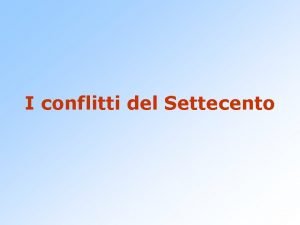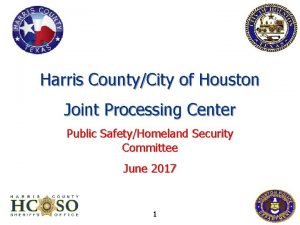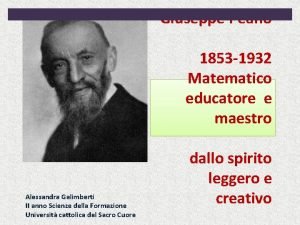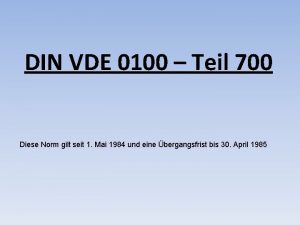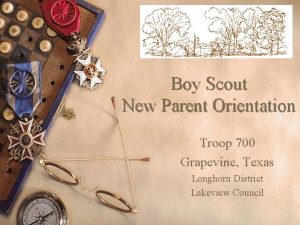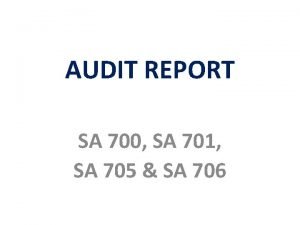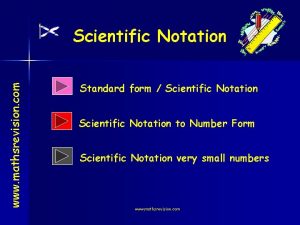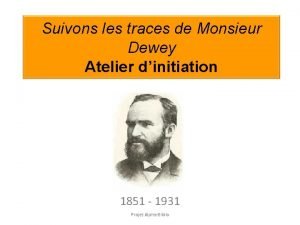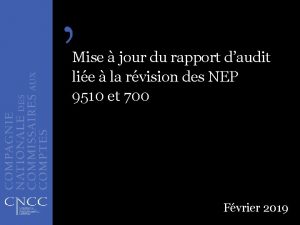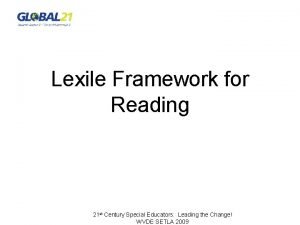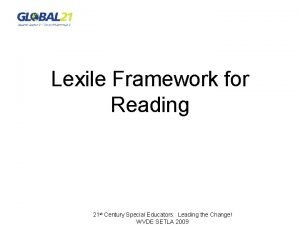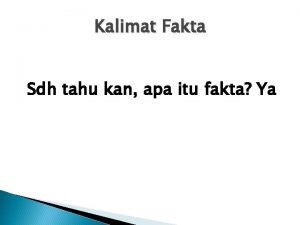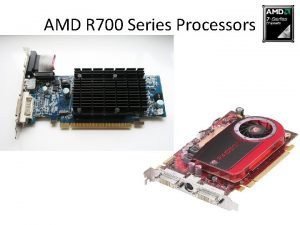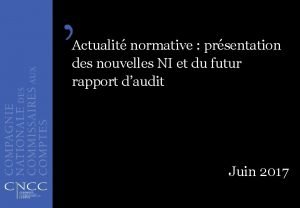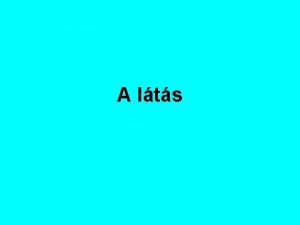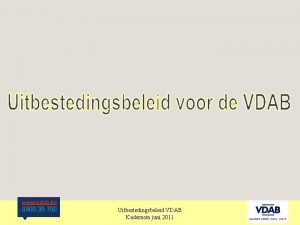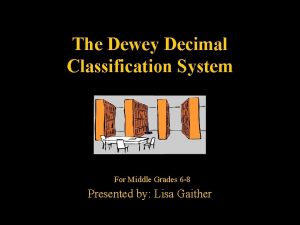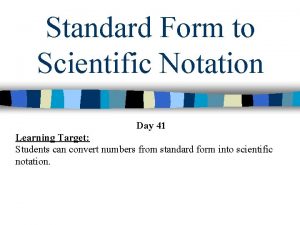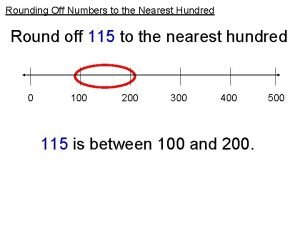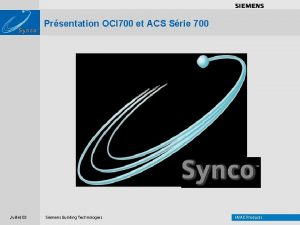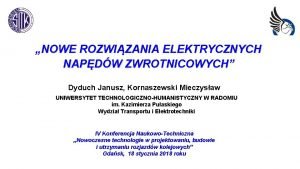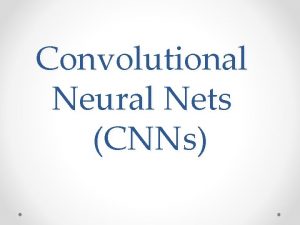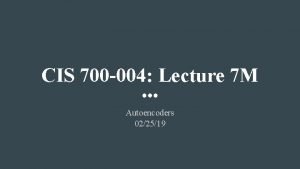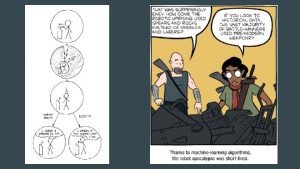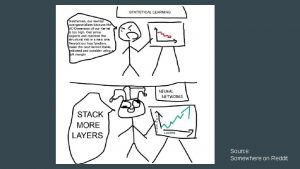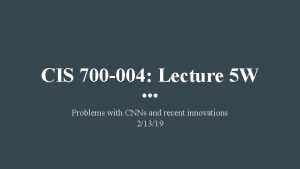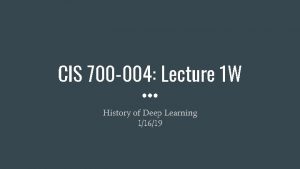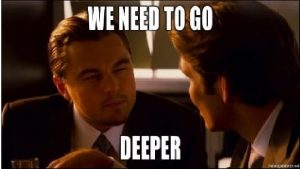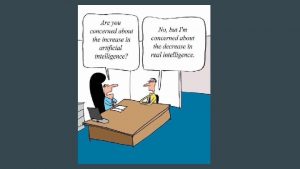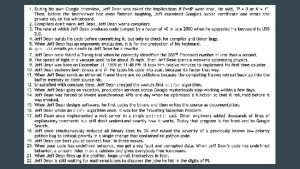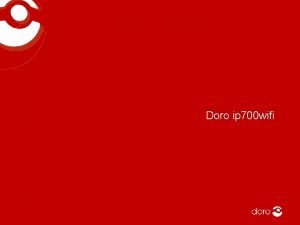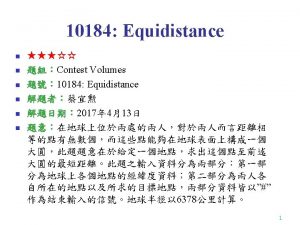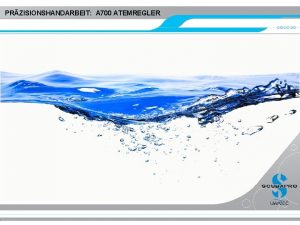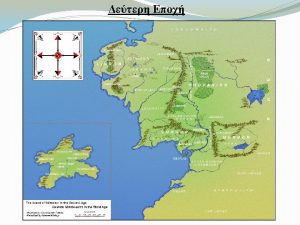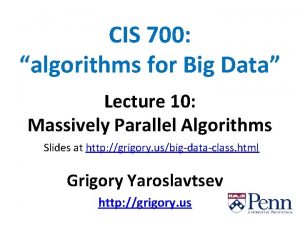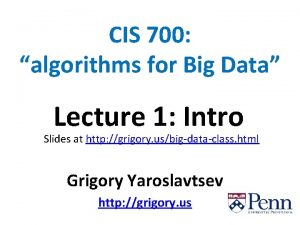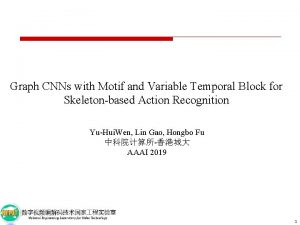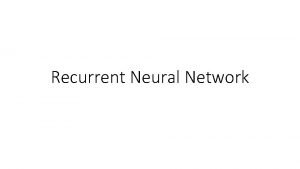CIS 700 004 Lecture 5 M CNNs and



























































- Slides: 59

CIS 700 -004: Lecture 5 M CNNs and Capsule Nets 02/10/19

Course Announcements ● HW 0 has been graded -- please post on Piazza for regrade requests. ● HW 1 has been released, due 2/22. Start early!

Today's Agenda ● ● ● Brief look at HW 1 A convolution exercise CNNs in Py. Torch CNN architectures Applications of CNNs Questioning translational invariance: the motivation for capsule nets

A convolution exercise

A convolution exercise Suppose we want to find out whether the following image depicts Cartesian axes. We do so by convolving the image with two filters (no padding, stride of 1) and applying a max-pool operation with kernel width of 2. Compute the output by hand.

A convolution exercise

A convolution exercise

A convolution exercise

A convolution exercise

A convolution exercise

Convolution exercise solution Grayscale image Filters Output of filters Output of max-pool

CNNs are translation-invariant by design. Although we would like many other kinds of invariance, none are baked into the architecture of CNNs.

CNNs in Py. Torch

Let's design a CNN. ● MNIST images have size 28 x 1 (black-and-white images have 1 feature / pixel) ● Design 2 conv. layers that reduce images to 7 x 7 and create 32 features. Specify your filter size, stride, and pooling kernel size. ● Finish classifying using a feedforward net. There are 10 labels.

Now let's build it in Py. Torch. https: //pytorch. org/docs/stable/nn. html#convolution-functions

Some classic CNNs

Architectures as inductive biases

CNNs perform extremely well on CV datasets.

CNNs perform extremely well on MNIST.

CNNs perform reasonably well on CIFAR-10 ● Feedforward neural nets achieve about 50% accuracy.

Le. Net (1998) -- Background ● Developed by Yann Le. Cun ○ ○ Worked as a postdoc at Geoffrey Hinton's lab Chief AI scientist at Facebook AI Research Wrote a whitepaper discovering backprop. Co-founded ICLR ● Problem: classify 7 x 12 bit images of 80 classes of handwritten characters.

Le. Net (1998) -- Architecture ● Convolution filter size: 5 x 5. ● Subsampling (pooling) kernel size: 2 x 2. ● Semi-sparse connections.

Le. Net (1998) -- Results ● Successfully trained a 60 K parameter neural network without GPU acceleration! ● Solved handwriting for banks -- pioneered automated check-reading. ● 0. 8% error on MNIST; near state-of-the-art at the time. ○ Virtual SVM, kernelized by degree 9 polynomials, also achieves 0. 8% error. Le. Net: http: //yann. lecun. com/exdb/publis/pdf/lecun-01 a. pdf SVM: http: //yann. lecun. com/exdb/publis/index. html#lecun-98

Le. Net in Py. Torch

Alex. Net (2012) -- Background ● Developed by ○ ○ ○ Alex Krizhevsky Ilya Sutskever ■ Chief scientist, Open. AI ■ Inventor of seq 2 seq learning. Geoffrey Hinton, Alex Krizhevsky's Ph. D adviser ■ Co-invented Boltzmann machines ● Problem: compete on Image. Net, Fei-Fei Li's dataset of 14 million images with more than 20, 000 categories (e. g. strawberry, balloon).

Alex. Net (2012) -- Architecture ● Input of 224 x 3 images. ● 8 weighted layers ○ ○ ○ 5 convolutional layers. ■ Filter width 11, then 5, then 3 ■ Stride 4 A lot of max-pooling layers ■ Kernel width 3 ■ Stride 2 3 fully connected layers. Re. LU activation until last layer (which was softmax) Trained with dropout and local response normalization

Alex. Net (2012) -- Results ● Smoked the competition with 15. 3% top-5 error (runner-up had 26. 2%) ● One of the first neural nets trained on a GPU with CUDA. ○ ○ (There had been 4 previous contest-winning CNNs) Trained 60 million parameters ● Cited over 30, 000 times: https: //papers. nips. cc/paper/4824 -imagenet-classificationwith-deep-convolutional-neural-networks. pdf

Alex. Net in Py. Torch import torchvision. models as models alexnet = models. alexnet()

Alex. Net in Py. Torch (source code)

VGG (2014) -- Background ● Developed by the Visual Geometry Group (Oxford) ● Problem: beat Alex. Net on Image. Net

VGG (2014) -- Architecture ● The deepest neural net ever. ● 138 million parameters

VGG (2014) -- Results ● Configuration E (19 weighted layers) achieved 8. 0% top-5 error. ● https: //arxiv. org/pdf/1409. 1556. pdf

VGG in Py. Torch import torchvision. models as models vgg 16 = models. vgg 16() No useful source code to speak of; the neural net is so prohibitively large (hence, a pain to train) that the model features are downloaded.

Inception / Google. Net (2015)

Inception v 1: tuning kernel size is hard. ● A computer scientist's solution: toss 'em all together. A single "Inception Module"

Inception v 3: compute, representational bottlenecks Original Later version ● Representational bottleneck: worse learning properties when the dimensions of the data are drastically changed all at once (more on that next week).

Inception (2014) -- Results ● 6. 67% top-5 error rate! ● Andrej Karpathy achieved 5. 1% top-5 error rate.

Performance of convolutional architectures on Image. Net

Applications of CNNs

Image recognition Cornell Lab of Ornithology, Merlin bird identification app (see Van Horn et al. 2015)

Gatys et al. (2016) Style transfer ● Content is measured by deeper layers. ● Style is measured by the correlations between feature vectors at lower layers. ● Objective 1: Minimize content difference between new image and content template. ● Objective 2: Minimize style difference between new image and style template.

Image segmentation U-Net (Ronneberger et al. 2015) Segmenting biological cell membranes

Insights of U-Net ● “Up-convolution” ○ Fixes the problem of shrinking images with CNNs ○ One example of how to make “fully convolutional” nets: pixels to pixels ○ “Up-convolution” is just upsampling, then convolution ○ Allows for refinement of the upsample by learned weights ○ Goes along with decreasing the number of feature channels ○ Not the same as “de-convolution”. ● Connections across the “U” in the architecture

3 D convolution Motion in videos - Tran et al. (2015) Objects from images w/ depths - Song & Xiao (2016)

Speech recognition Zhang et al. 2017 ● CNN competitive with RNNs (e. g. LSTMs) ● 10 layers, 3 x 5 conv, 3 x 1 pooling - deep enough for temporal dependencies ● TIMIT task, classifying phonemes

Graph convolution ● For a full intro: https: //tkipf. github. io/graph-convolutional-networks/ ● Basic idea: ○ ○ ○ A convolution for matrices is a “local” combination of entries in the matrix Can do the same thing for a graph Here, “local” is whatever nodes a node is adjacent to ● Just the tip of an iceberg… ● Used in learning stuff about molecules, citations, social networks, etc.

Myth: CNNs are for computer vision, and RNNs are for NLP.

CNNs are SOTA in many NLP tasks https: //github. com/bentrevett/pytorch-sentiment-analysis/blob/master/4%20%20 Convolutional%20 Sentiment%20 Analysis. ipynb

Capsule Nets

Capsule networks agenda ● ● Why convolutional neural networks and translational invariance suck. Formulating a better prior. The capsule architecture. The dynamic routing algorithms

Geoffrey Hinton ● English-Canadian cognitive psychologist and computer scientist ● Popularized backpropagation ● The "Godfather of Deep Learning" ● Co-invented Boltzmann machines ● Contributed to Alex. Net ● Advised Yann Le. Cunn, Ilya Sutskever, Radford Neal, Brendan Frey ● Creator of capsule nets

Convolutional neural networks can be a mess. 1. 2. 3. 4. Solves the wrong problem: we want equivariance, not invariance. Bad fit to the psychology of shape perception. Does not use underlying linear structure of the universe. Fails to route information intelligently: max pooling sucks.

1. Translational invariance is the wrong problem The Picasso problem: convolutional neural networks detect parts with no sense of a whole.

2, 3. Bad fit to human perception and structure of motion https: //youtu. be/r. Taw. Fw. Uvn. LE? t=835 https: //youtu. be/r. Taw. Fw. Uvn. LE? t=1195

4. Pooling sucks ● Does not account for the offset in its computation. ● Ensure that information about localization is erased. ● Certainly doesn't intelligently send information to the appropriate neurons. ○ E. g. if my data has (age, weight, sex) and my model has a neurons abstracting (sex, age, weight), there should ideally be a way to route the information to the right place.

“The pooling operation used in convolutional neural networks is a big mistake and the fact that it works so well is a disaster. ” -- Geoffrey Hinton

Given all these problems with CNNs, what might we hope for from a superior architecture?

Our wishlist for a new architecture ● Awesome priors ○ ○ Ontology: the world is made up of objects that have properties. Inverse-graphics: objects move linearly in space (translation) and rotate. ● Information is properly routed to the appropriate neurons. ○ Routes by "agreement" rather than by "volume. " ● Super interpretable ○ ○ Clear representation of learned features Visualization of internal representation ● Learns with very few examples (fewer than 5 per class? ) ● Outperforms CNNs in accuracy ● Runs blazingly fast

Our wishlist for a new architecture ● Awesome priors ○ ○ the world is made up of objects that have properties. objects move linearly in space (translation) and rotate. ● Information is properly routed to the appropriate neurons. ○ Routes by "agreement" rather than by "volume. " ● Super interpretable ○ ○ Clear representation of learned features Visualization of internal representation ● Learns with very few examples (fewer than 5 per class? ) ● Outperforms CNNs in accuracy ● Runs blazingly fast
 700-004 vt
700-004 vt Cis 700
Cis 700 Cis 700
Cis 700 Cis 700
Cis 700 Cis 700
Cis 700 Degression des charges d'exploitation
Degression des charges d'exploitation Pyp 004 kfupm
Pyp 004 kfupm Auec2-004
Auec2-004 Sol
Sol Team-004
Team-004 0560 004
0560 004 Wärmetönungssensor
Wärmetönungssensor 01:640:244 lecture notes - lecture 15: plat, idah, farad
01:640:244 lecture notes - lecture 15: plat, idah, farad Are cis and trans diastereomers
Are cis and trans diastereomers Diastereomers
Diastereomers Cahn ingold prelog rules
Cahn ingold prelog rules Cis face and trans face
Cis face and trans face 080030700
080030700 Ultra glide the watsons go to birmingham
Ultra glide the watsons go to birmingham Ttab 700 ultra glide
Ttab 700 ultra glide The browns go to birmingham
The browns go to birmingham Trent 700 engine diagram
Trent 700 engine diagram 700 ad
700 ad Nbc ta 701
Nbc ta 701 Maz truck
Maz truck Guerra dei 7 anni
Guerra dei 7 anni Questione della lingua nel 600
Questione della lingua nel 600 Alimentazione nel 700
Alimentazione nel 700 Polycom vsx 8000
Polycom vsx 8000 Guerre del '700 schema
Guerre del '700 schema Harris county jail 700 san jacinto
Harris county jail 700 san jacinto Giuseppe grande matematico del 700
Giuseppe grande matematico del 700 Din vde 0100 teil 737
Din vde 0100 teil 737 Troop 700
Troop 700 Sa 705
Sa 705 Greece 700 bc
Greece 700 bc 700 convention way anaheim ca
700 convention way anaheim ca 120 700 in scientific notation
120 700 in scientific notation 737-300 elearning
737-300 elearning Dewey 000
Dewey 000 Security container check sheet
Security container check sheet Nep 9510
Nep 9510 600-700 lexile books
600-700 lexile books 600-700 lexile books
600-700 lexile books Nep 702
Nep 702 Pemkot depok telah menertibkan 700 pedagang kaki lima
Pemkot depok telah menertibkan 700 pedagang kaki lima Olmec
Olmec Troop 700
Troop 700 600 yüzlüğe yuvarlama
600 yüzlüğe yuvarlama Amd 700 series
Amd 700 series Nep 700 audit
Nep 700 audit Hemidecussation
Hemidecussation Www vdab be
Www vdab be Dewey decimal system mythology
Dewey decimal system mythology What is 97 000 in scientific notation
What is 97 000 in scientific notation Round 650 to the nearest hundred
Round 650 to the nearest hundred 700 round off
700 round off Oci 700
Oci 700 Dyduch janusz
Dyduch janusz Sf 701 example
Sf 701 example
